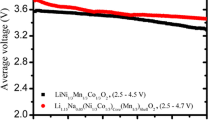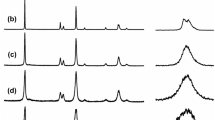Abstract
Although low solid solubility and activity of LiFeO2 in xLi2MnO3·(1–x)LiFeO2 limit its practical application, it still has the potential to become a new-generation cathode material without cobalt or nickel for Li-ion batteries. In order to understand the effects of the local structures of different LiMO2 (M = Co, Ni, Fe) layered materials on their solid solubility in Li2MnO3, partial densities of states are calculated to determine the Jahn–Teller distortion in the layered cathode material, and the first-principles calculation method based on density functional theory is used to optimize and compare the local structures of LiCoO2, LiNiO2, LiFeO2, LiMnO2, and Li2MnO3. The degrees of distortion of the transition metal–oxygen (M–O) and lithium–oxygen (Li–O) octahedra in the crystal structure of the material are evaluated. It is clear that the solid solubility of layered materials is related to the bond lengths and degrees of distortion of the M–O and Li–O octahedra. Among them, the similar bond length of LiNiO2 and Li2MnO3 and the high distortion of NiO6 enhance the solid solubility of LiNiO2 in Li2MnO3. Owing to the absence of Jahn–Teller distortion in LiFeO2 and LiCoO2, the FeO6 and CoO6 octahedra are slightly distorted, thereby decreasing the solid solubility of LiMO2 (M = Fe, Co) in Li2MnO3. Understanding the relation between intra-octahedral distortion and solid solubility provides simple and efficient evidence for comparing the solid solubilities of different LiMO2 layered materials in the Li2MnO3 of Li-rich cathode materials. This study can be used as a reference for component design in Li-rich materials.
Graphic Abstract




Similar content being viewed by others
References
Zeng, X., Li, M., El-Hady, D.A., Alshitari, W., Al-Bogami, A.S., Lu, J., Amine, K.: Commercialization of lithium battery technologies for electric vehicles. Adv. Energy Mater. 9(27), 1900161 (2019). https://doi.org/10.1002/aenm.201900161
Armand, M., Tarascon, J.M.: Building better batteries. Nature 451(7179), 652–657 (2008). https://doi.org/10.1038/451652a
Schipper, F., Erickson, E.M., Erk, C., Shin, J.Y., Chesneau, F.F., Aurbach, D.: Review-recent advances and remaining challenges for lithium ion battery cathodes. J. Electrochem. Soc. 164(1), A6220–A6228 (2017). https://doi.org/10.1149/2.0461701jes
Yu, H., Zhou, H.: High-energy cathode materials (Li2MnO3-LiMO2) for lithium-ion batteries. J. Phys. Chem. Lett. 4(8), 1268–1280 (2013). https://doi.org/10.1021/jz400032v
Han, S., Xia, Y., Wei, Z., Qiu, B., Pan, L., Gu, Q., Liu, Z., Guo, Z.: A comparative study on the oxidation state of lattice oxygen among Li1.14Ni0.136Co0.136Mn0.544O2. J. Mater. Chem. A 3(22), 11930–11939 (2015). https://doi.org/10.1039/C5TA02161H
Luo, K., Roberts, M.R., Hao, R., Guerrini, N., Pickup, D.M., Liu, Y., Edström, K., Guo, J., Chadwick, A.V., Duda, L.C., Bruce, P.G.: Charge-compensation in 3d-transition-metal-oxide intercalation cathodes through the generation of localized electron holes on oxygen. Nat. Chem. 8(7), 684–691 (2016). https://doi.org/10.1038/nchem.2471
Kang, S.L., Thackeray, M.M.: Enhancing the rate capability of high capacity xLi2MnO3·(1–x)LiMO2 (M=Mn, Ni, Co) electrodes by Li-Ni-PO4 treatment. Electrochem. Commun. 11(4), 748–751 (2009). https://doi.org/10.1016/j.elecom.2009.01.025
Hu, S., Pillai, A.S., Liang, G., Pang, W.K., Wang, H., Li, Q., Guo, Z.: Li-Rich layered oxides and their practical challenges: recent progress and perspectives. Electrochem. Energy Rev. 2(2), 277–311 (2019). https://doi.org/10.1007/s41918-019-00032-8
Nayak, P.K., Erickson, E.M., Schipper, F., Penki, T.R., Munichandraiah, N., Adelhelm, P., Sclar, H., Amalraj, F., Markovsky, B., Aurbach, D.: Review on challenges and recent advances in the electrochemical performance of high capacity Li- and Mn-Rich cathode materials for Li-Ion batteries. Adv. Energy Mater. 8(8), 1702397 (2018). https://doi.org/10.1002/aenm.201702397
Lu, Z., Chen, Z., Dahn, J.R.: Lack of cation clustering in Li[NixLi1/3-2x/3Mn2/3-x/3]O2 and Li[CrxLi(1–x)/3Mn(2–2x)/3]O2 (0<x<1). Chem. Mater. 15(16), 3214–3220 (2003). https://doi.org/10.1021/cm030194s
Jarvis, K.A., Deng, Z., Allard, L.F., Manthiram, A., Ferreira, P.G.: Atomic structure of a Lithium-Rich layered oxide material for Lithium-Ion batteries: evidence of a solid solution. Chem. Mater. 23(16), 3614–3621 (2011). https://doi.org/10.1021/cm200831c
Tabuchi, M., Nabeshima, Y., Shikano, M., Ado, K., Kageyama, H., Tatsumi, K.: Optimizing chemical composition and preparation conditions for Fe-substituted Li2MnO3 positive electrode material. J. Electrochem. Soc. 154(7), A638–A648 (2007). https://doi.org/10.1149/1.2732223
Kikkawa, J., Akita, T., Tabuchi, M., Shikano, M., Tatsumi, K., Kohyama, M.: Fe-rich and Mn-rich nanodomains in Li1.2Mn0.4Fe0.4O2 positive electrode materials for lithium-ion batteries. Appl. Phys. Lett. 91(5), 054103 (2007). https://doi.org/10.1063/1.2757587
Boivin, E., Guerrini, N., House, R.A., Lozano, J.G., Jin, L., Rees, G.J., Somerville, G.W., Kuss, C., Roberts, M.R., Bruce, P.G.: The role of Ni and Co in suppressing O-Loss in Li-rich layered cathodes. Adv. Funct. Mater. 32(2), 2003660 (2020). https://doi.org/10.1002/adfm.202003660
Wu, Y., Pasero, D., McCabe, E.E., Matsushima, Y., West, A.R.: Partial cation-order and early-stage, phase separation in phase W, LixCo1-xO: 0.075≤x≤0.24–0.31. P. Roy. Soc. A-Math. Phy. 465(2106), 1829–1841 (2009). https://doi.org/10.1098/rspa.2008.0489
Meng, Y.S., Dompablo, M.E.A.: Recent advances in first principles computational research of cathode materials for Lithium-Ion batteries. Acc. Chem. Res. 46(5), 1171–1180 (2013). https://doi.org/10.1021/ar2002396
Amriou, T., Khelifa, B., Aourag, H., Aouadi, S.M., Mathieu, C.: Ab initio investigation of the Jahn-Teller distortion effect on the stabilizing lithium intercalated compounds. Mater. Chem. Phys. 92(2–3), 499–504 (2005). https://doi.org/10.1016/j.matchemphys.2005.01.061
Meay, D.D., Marianetti, C., Ven, A.D.V., Ceder, G.: Jahn-Teller mediated ordering in layered LixMO2 compounds. Phys. Rev. B. 63(14), 144107 (2001). https://doi.org/10.1103/PhysRevB.63.144107
Huang, Z., Zhang, H., Wang, C., Wang, D., Meng, X., Ming, X., Chen, G.: First-principles investigation on extraction of lithium ion from monoclinic LiMnO2. Solid State Sci. 11(1), 271–274 (2009). https://doi.org/10.1016/j.solidstatesciences.2008.06.005
Kresse, G., Joubert, D.: From ultrasoft pseudopotentials to the projector augmented-wave method. Phys. Rev. B. 59(3), 1758–1775 (1999). https://doi.org/10.1103/PhysRevB.59.1758
Anisimov, V.I., Zaanen, J., Andersen, O.K.: Band theory and mott insulators: Hubbard U instead of stoner-I. Phys. Rev. B. 44(3), 943–954 (1991). https://doi.org/10.1103/PhysRevB.44.943
Anisimov, V.I.: First-principles calculations of the electronic structure and spectra of strongly correlated systems: LDA+U method. Springer Ser. Solid-State Sci. 119, 106–116 (1995)
Monkhorst, H.J., Pack, J.D.: Special points for Brillouin-zone integrations[J]. Phys. Rev. B Condens. Matter. 13(12), 5188–5192 (1976)
Gao, Y., Wang, X., Ma, J., Wang, Z., Chen, L.: Selecting substituent elements for Li-Rich Mn-based cathode materials by density functional theory (DFT) calculations. Chem. Mater. 27(9), 3456–3461 (2015). https://doi.org/10.1021/acs.chemmater.5b00875
Li, B., Yan, H., Ma, J., Yu, P., Xia, D., Huang, W., Chu, W., Wu, Z.: Manipulating the electronic structure of Li-Rich manganese-based oxide using polyanions: towards better electrochemical performance. Adv. Funct. Mater. 24(32), 5112–5118 (2014). https://doi.org/10.1002/adfm.201400436
Robertson, A.D., Bruce, P.G.: Mechanism of electrochemical activity in Li2MnO3. Chem. Mater. 15(10), 1984–1992 (2003). https://doi.org/10.1021/cm030047u
Kikkawa, J., Akita, T., Tabuchi, M., Shikano, M., Tatsumi, K., Kohyama, M.: Coexistence of layered and cubic rocksalt structures with a common oxygen sublattice in Li1.2Mn0.4Fe0.4O2 particles: a transmission electron microscopy study. J. Appl. Phys. 103(10), 104911 (2008). https://doi.org/10.1063/1.2931002
Tabuchi, M., Nabeshima, Y., Takeuchi, T., Tatsumi, K., Imaizumi, J., Nitta, Y.: Fe content effects on electrochemical properties of Fe-substituted Li2MnO3 positive electrode material. J. Power Sources 195(3), 834–844 (2010). https://doi.org/10.1016/j.jpowsour.2009.08.059
Acknowledgements
This work was supported by Beijing Municipal Education Commission (KZ201910005003).
Author information
Authors and Affiliations
Corresponding author
Ethics declarations
Conflict of Interest
The authors declare no conflict of interest.
Additional information
Publisher's Note
Springer Nature remains neutral with regard to jurisdictional claims in published maps and institutional affiliations.
Rights and permissions
About this article
Cite this article
Hou, C., Xiao, X., Xing, YR. et al. Relation Between the Local Structure and Solid Solubility of the Layered Material LiMO2 (M = Co, Ni, Fe) in Li2MnO3. Electron. Mater. Lett. 18, 104–111 (2022). https://doi.org/10.1007/s13391-021-00316-6
Received:
Accepted:
Published:
Issue Date:
DOI: https://doi.org/10.1007/s13391-021-00316-6




